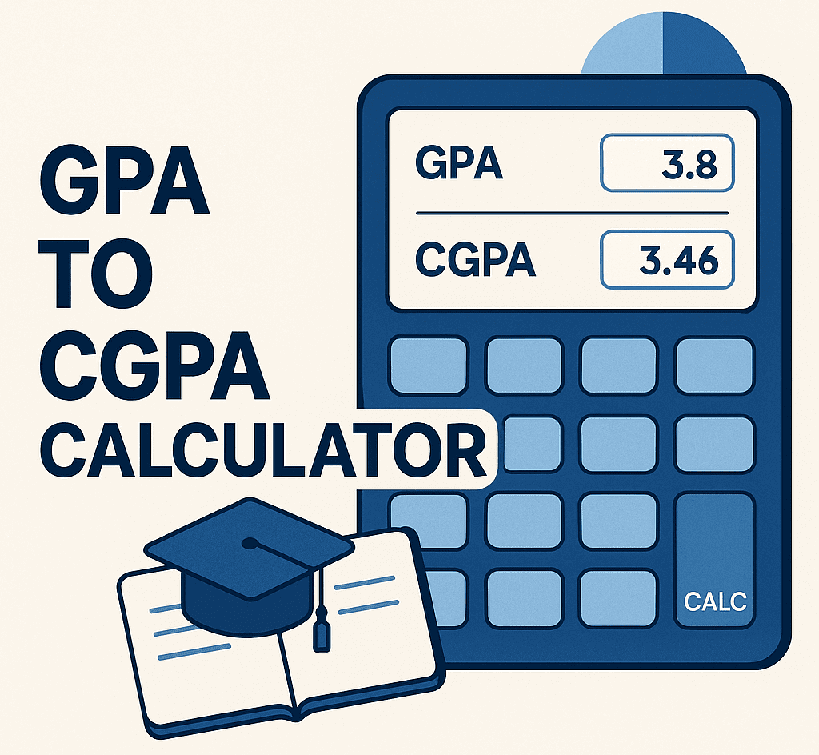GPA to CGPA Calculator
Free Online GPA to CGPA Calculator for College and University Students
GPA to CGPA Calculator
Convert your GPA to CGPA based on different grading scales
Enter GPA on 4.0 scale
GPA to CGPA Convertor
A GPA to CGPA Calculator is a practical online tool designed to help students understand their overall academic performance based on individual course grades.
It takes your Grade Point Average (GPA), typically calculated on a semester or term basis, and converts it into a Cumulative Grade Point Average (CGPA).
The CGPA provides a comprehensive summary of your academic achievements across all semesters or terms completed so far.


How to Use this Calculator?
This GPA to CGPA calculator is designed to be straightforward and easy to use. Here’s a step-by-step guide:
1) Enter your GPA: In the input field labeled “Enter your GPA,” type in your Grade Point Average. Make sure to enter the GPA on a 4.0 scale, as indicated by the hint below the input box. For example, you might enter 3.5.
2) Select University (Optional): The “University (Optional)” dropdown allows you to choose a specific university if you know it uses a particular formula for converting GPA to CGPA.
If you are unsure or the university you’re interested in isn’t listed, leave the selection as “Default (General Formula).”
If your university is listed (e.g., VTU, Mumbai University, etc.), selecting it will apply a conversion formula specific to that institution.
3) Choose Target CGPA Scale: In the “Target CGPA Scale” section, select the scale you want your CGPA to be calculated on. The calculator defaults to a 10.0 scale (common in India), but you can also choose a 5.0 or 4.0 scale by clicking on the corresponding box. The active scale will be highlighted with a blue border.
4) Click “Calculate CGPA”: Once you have entered your GPA and selected the desired CGPA scale (and optionally a university), click the “Calculate CGPA” button.
View Your Results: After clicking the button, the “Results Section” will appear (if it was hidden). This section displays:
Your CGPA is: The calculated CGPA value based on your input GPA, the selected university (if any), and the target CGPA scale.
On [Scale] scale: The target CGPA scale you selected.
Gauge Visualization: A circular chart visually representing your CGPA as a percentage of the selected scale. The color of the gauge indicates a general performance level (e.g., green for high, red for low).
GPA to CGPA Comparison: A bar chart comparing your input GPA (on a 4.0 scale) with your calculated CGPA (on the selected scale). This helps visualize the difference between the two grading systems.
Bridging the Academic Divide: What is GPA to CGPA Calculator
In today’s interconnected world, academic achievements are often evaluated across diverse grading systems.
While the Grade Point Average (GPA) on a 4.0 scale reigns supreme in many North American and some international universities, other systems like the Cumulative Grade Point Average (CGPA) on a 10-point scale are prevalent in countries like India.
This difference can create confusion for students seeking to understand their academic standing in a global context.
Enter the GPA to CGPA calculator, a vital online tool that acts as a bridge between these systems, offering clarity and facilitating academic transitions.
What is a GPA to CGPA Calculator?
At its core, a GPA to CGPA calculator is an online utility designed to convert a Grade Point Average (typically on a 4.0 scale) into an equivalent Cumulative Grade Point Average (often on a 10-point scale).
It takes a student’s GPA as input and, using predefined formulas or general conversion methods, estimates the corresponding CGPA.
The need for such a tool arises from the fact that these two grading systems, while both representing academic performance, operate on different scales and sometimes employ varying calculation methodologies.
A GPA usually reflects the average grade points earned in a specific semester or term, while a CGPA represents the cumulative average of grade points across all completed semesters or terms.
Understanding the Utility: Why Use a GPA to CGPA Calculator?
The GPA to CGPA calculator offers several key benefits, particularly for students:
- International Academic Opportunities: For students aspiring to study at universities in the US, Canada, the UK, or other regions using the GPA system, understanding how their CGPA translates to a GPA is crucial for meeting admission requirements.
- Self-Assessment and Benchmarking: Students familiar with the CGPA system can use the calculator to gauge how their performance might be perceived by institutions using a GPA scale. This allows for self-assessment and helps in setting realistic academic goals.
- Scholarship Applications: Many international scholarships specify GPA requirements. Converting your CGPA to GPA can help determine your eligibility for these opportunities.
- Resume and Curriculum Vitae (CV): When applying for international internships or jobs, providing a GPA equivalent alongside your CGPA can make your academic record more readily understandable to a global audience.
- Simple and Quick Conversion: The calculator eliminates the need for manual and potentially complex calculations, providing instant results.
GPA to CGPA Examples: Illuminating the Conversion
It’s important to understand that the conversion from GPA to CGPA isn’t always a direct linear transformation. Different universities and general conversion methods might employ slightly varying formulas. However, a common general approach often involves a multiplier.
General Example:
A widely used general formula approximates the conversion as:
CGPA≈GPA×2.5
Let’s consider a few scenarios:
- Example 1: A student has a GPA of 3.2 on a 4.0 scale. Using the general formula: CGPA≈3.2×2.5=8.0 This suggests that a GPA of 3.2 might roughly correspond to a CGPA of 8.0 on a 10-point scale.
- Example 2: Another student has a slightly higher GPA of 3.8. CGPA≈3.8×2.5=9.5 A GPA of 3.8 could be estimated as a CGPA of 9.5.
University-Specific Examples (Illustrative):
It’s crucial to note that some universities have their own specific conversion formulas. While the general formula provides a rough estimate, using a university-specific calculator (if available) or their official conversion guidelines will yield more accurate results.
For instance, a hypothetical university might use a formula like:
CGPA=(GPA×2.5)+0.5
In this case, a GPA of 3.2 would translate to:
CGPA=(3.2×2.5)+0.5=8.0+0.5=8.5
As seen in the provided HTML code, some calculators even offer specific conversion options for universities like VTU, Mumbai University, MAKAUT, GTU, SPPU, JNTU, Anna University, AKTU, IPU, Delhi University, BITS Pilani, Amity University, SRM University, VIT, and LPU. These often employ formulas tailored to the grading patterns of these institutions.
Important Considerations:
- Not an Exact Science: Conversions between GPA and CGPA are often estimations. The underlying grading philosophies and the distribution of grades can differ significantly between systems and institutions.
- University Policies are Key: When applying to a specific university, always refer to their official website or admission guidelines for their preferred method of GPA to CGPA (or vice versa) conversion. Some universities might even recalculate GPA based on their own criteria.
- Percentage Equivalency: Many GPA to CGPA calculators also provide an estimated percentage equivalent. This can offer another perspective on academic performance.
- Scale Awareness: Always be mindful of the scale being used for both GPA (usually 4.0) and CGPA (commonly 10.0, but can also be 5.0 or 4.0 in some contexts).
Conclusion:
The GPA to CGPA calculator is a valuable tool in navigating the diverse landscape of international academic grading systems.
By providing a quick and relatively accurate conversion, it empowers students to understand their academic standing in a broader context, explore international opportunities with greater clarity, and present their achievements effectively to a global audience.
However, it’s essential to remember that these conversions are often estimations, and relying on official university guidelines is paramount when making important academic decisions.
This handy online tool serves as a crucial stepping stone in bridging the academic divide and fostering global educational mobility.
